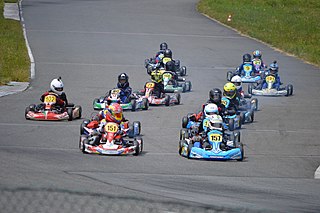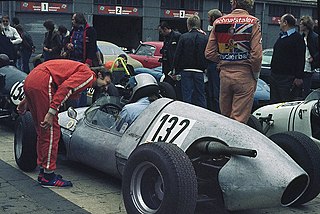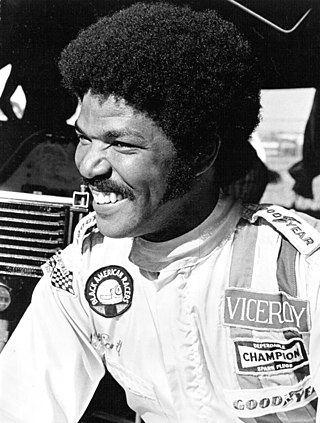
Kart racing or karting is a motorsport discipline using open-wheel, four-wheeled vehicles known as go-karts or shifter karts. They are usually raced on scaled-down circuits, although some professional kart races are also held on full-size motorsport circuits. Karting is commonly perceived as the stepping stone to the higher ranks of motorsports, with most Formula One drivers—including Ayrton Senna, Michael Schumacher, Fernando Alonso, Kimi Räikkönen, Lewis Hamilton, Sebastian Vettel, Nico Rosberg, and Max Verstappen—having begun their careers in karting.

Formula Three, also called Formula 3, abbreviated as F3, is a third-tier class of open-wheel formula racing. The various championships held in Europe, Australia, South America and Asia form an important step for many prospective Formula One drivers.
The International Motor Sports Association (IMSA) is a North American sports car racing sanctioning body based in Daytona Beach, Florida under the jurisdiction of the ACCUS arm of the FIA. It was started by John Bishop, a former executive director of SCCA, and his wife Peggy in 1969 with help from Bill France Sr. of NASCAR. Beginning in 2014, IMSA is the sanctioning body of the WeatherTech SportsCar Championship, the premier series resulting from the merger of Grand-Am Road Racing and the American Le Mans Series. IMSA is owned by NASCAR, as a division of the company.

Formula Junior is an open wheel formula racing class first adopted in October 1958 by the CSI. The class was intended to provide an entry level class where drivers could use inexpensive mechanical components from ordinary automobiles. The idea to form the new class came from Count Giovanni "Johnny" Lurani who saw the need of a class for single-seater racing cars where younger drivers could take their first steps. It is often speculated that this class was founded as a reaction to Italy's lack of success in the 500cc Formula Three, and although Italian marques dominated the first year of the formula, they were soon overtaken by British constructors.
The Atlantic Championship Series is an American open-wheel racing series with races throughout North America. It has previously been called Champ Car Atlantics, Toyota Atlantics, or just Atlantics

Formula Ford, also known as F1600 and Formula F, is an entry-level class of single-seater, open-wheel formula racing. The various championships held across the world form an important step for many prospective Formula One drivers. Formula Ford has traditionally been regarded as the first major stepping stone into formula racing after karting. The series typically sees career-minded drivers enter alongside amateurs and enthusiasts. Success in Formula Ford can lead directly to other junior formula series such as a Formula Renault 2.0 and Formula Three, or the W Series for female drivers.
The Barber Dodge Pro Series was a professional open-wheel auto racing series from 1986 to 2003. It was one of the first professional spec series for open-wheel racecars in North America. The races were primarily on road and street courses in North America, although the schedule did sometimes include a few ovals.

Formula Atlantic is a specification of open-wheel racing car developed in the 1970s. It was used in professional racing through the IMSA Atlantic Championship until 2009 and is currently primarily used in amateur racing through Sports Car Club of America Formula Atlantic.

Devin Enterprises was an American automotive manufacturer that operated from 1955 to 1964. Devin was mainly known for producing high quality fiberglass car bodies that were sold as kits, but they also produced automotive accessories as well as complete automobiles. The company was founded by Bill Devin.

Formula Super Vee was an open-wheel racing series that took place in Europe and the United States from 1970 to 1990. The formula was created as an extension of Formula Vee, a racing class that was introduced in 1959. Formula Super Vee in Europe was similar to F3 or Formula Renault today, a stepping stone to F1. In the United States, Formula Super Vee, often referred to as Super Vee, was a natural progression to Indy Car and Can-Am. On both sides of the Atlantic the series also was a platform for the promotion of VW products, similar to how Formula Renault promotes Renault products today.

Formula 1000 (F1000) is a class of open wheel formula racing with professional and amateur series worldwide. Formula 1000 gets its name from the 1000 cc super-bike engine used to power a single seat, open wheel race car with fully adjustable wings and suspension.
750 Motor Club is a motor racing club in the UK. It was founded in 1939 to promote the sporting use of the Austin 7. '750' refers to the near-750cc Austin 7 engine. It later led to racing and the 750 Formula where specials are raced. Famous members include Colin Chapman, Eric Broadley, Adrian Reynard, Arthur Mallock, Derek Bennett, Tony Southgate, Brian Hart, Gordon Murray, Jem Marsh, Frank Costin and Mike Pilbeam. These engineers and designers produced the first Lotus, Lola, Chevron, Speedex, Marcos, Pilbeam and other sports and racing cars between the 1940s and 1960s.

Borland Racing Developments is an Australian championship winning manufacturer of open-wheel racing cars, principally in the junior categories of Formula Ford and Formula Vee.

Benny Scott, was a second-generation African American race car driver, a rarity in the motor racing industry. Scott's father, Bill "Bullet" Scott, inspired his son racing midgets in Southern California in the 1930s.

The Volkswagen Jetta TDI Cup was a single-make racing series sanctioned by the Sports Car Club of America. The series was started in 2008 and was a sports car series that ran only in North America, the series quietly folded in 2011.

The USF2000 Championship Presented by Continental Tire is an American racing series using an American variation of the Formula Ford standard, "F2000", that resumed operation for the 2010 season. As of 2022, it is sanctioned by the United States Auto Club, and is the second rung of the Road to Indy.

The Ralt RT1 is a race car chassis produced by Ralt, and was the first modern car produced by the company. It saw widespread use in a number of different motorsports categories, mostly open-wheel racing, but later including sports car racing. It was powered by a number of different four-cylinder engines of about 1.6 L (98 cu in) in displacement, of different origin, including Hart, Cosworth, Toyota, and Volkswagen engines.
The SCCA Formula Super Vee was one of the longest running Formula Super Vee championships in the world. Twenty racing season were contested. Most of the races were sanctioned by the Sports Car Club of America in some occasions the races were sanctioned by the International Motor Sports Association.

The introduction of the Formula Vee concept to New Zealand can be attributed to Barry Munro, an Officer in the New Zealand Army who constructed the country's inaugural Formula Vee. Commencing chassis design in 1966, Munro finalized the first mock-up by November of that year, with the vehicle being fully assembled by March 1967. Notably, adherence to regulatory standards of the time required all racing cars to be registered, with the Munro Vee obtaining its initial registration on February 10, 1967. Munro's design prioritized affordability within the constraints of available technology. Notably, the nose cone was fashioned from a wool coat shaped over metal ribs and set with resin. Throughout the 1967 season, Munro actively competed with the car, participating in various classes to bolster its visibility and generate interest in Formula Vee racing. Subsequently, Digby Taylor followed suit in constructing his own Formula Vee, leading to the organization of the inaugural all-Formula Vee race.
Stuart Crow is an American former racing driver. Crow won the 1990 United States Formula Super Vee Championship and the 2000 United States Formula 3 Championship.
















